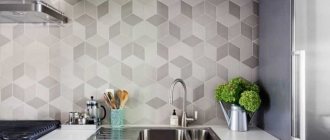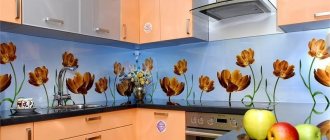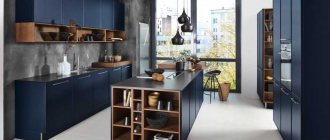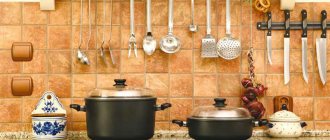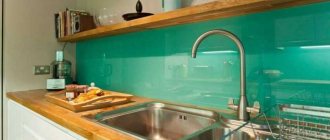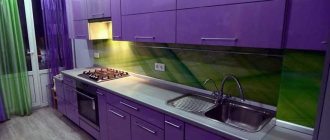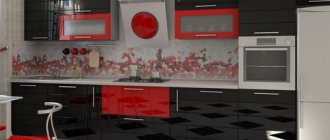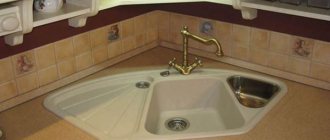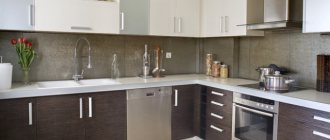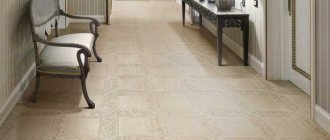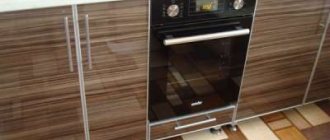Any kitchen planner and designer will tell you that a tile backsplash can instantly transform a space. Regardless of the shade of color, texture, water resistance - a decent kitchen apron is the best choice! Find out what types of ceramic tiles for kitchen backsplashes come in, how to match them to your kitchen design, popular sizes, types and decors of kitchen tiles.
A well-made kitchen backsplash is a brilliant accent piece and one of the best-selling kitchen decor items with interesting textures, colors and patterns. Determining the best tile for a kitchen backsplash is a matter of preference and a willingness to experiment. However, there are some things to know when looking for your dream tile.
Ceramic kitchen apron
This type of cladding, pictured above, can be found in every second kitchen in our country. The installation of plain and medium-color tiles using standard techniques deserves attention. This apron looks simple and reliable, and is also the most budget-friendly and versatile option.
Ceramic tiles are a traditional and still popular solution. Only a few years ago tiles in the 10x10 cm format prevailed, but nowadays large formats of ceramic tiles, polished porcelain tiles laid with thin joints, structural tiles or hexagons are gaining popularity in modern kitchens.
In any case, such a kitchen apron is very practical, easy to clean and durable. The availability of formats, structures, colors of ceramics and porcelain tiles means that they can be used to furnish a kitchen in any style.
Large format tiles placed above the worktop mean that the kitchen wall becomes a smooth, virtually seamless surface that blends perfectly with the worktop or floor. Large format tiles are produced in countless colors, which is their added advantage.
Mosaic tiles for kitchen
Mosaic is a cladding consisting of small elements that can be successfully used on the walls and floor of the kitchen. It can be made of ceramics, glass, natural stone and even metal or wood. It is also possible to combine different materials. This combination gives unlimited decorative possibilities. The biggest advantage, besides its charm, is the ability to easily adapt to the most bizarre curves and uneven surfaces.
Small elements that have geometric shapes of regular or varied shapes create beautiful compositions, thanks to which the wall in the kitchen receives not only the usual protection from moisture or dirt, but also becomes a central element.
Boar tile for kitchen backsplash
When you are going to buy ceramic hog tiles, remember that you need to add about 10% to the amount you calculated in case some tiles break as a result of unsuccessful cutting and other possible defects. Thus, you will be insured against forced downtime in the middle of the work process.
The most popular styles for boar tiles are Scandinavian style, Provence, industrial style and country. The “boar” at the base of the apron allows you to create the most unexpected compositions. This is achieved using tiles that vary in color, texture and size. If you have chosen an older kitchen style, it is best to buy tiles that are coated with a glaze, which causes small cracks to form on the surface of the tiles. A “hog” with a matte surface is best suited for some design areas.
Green tiles are suitable for country style, you can say about blue shades that look bright and attract all the attention to each other. But most housewives prefer chic and cheerful red aprons.
How much does it cost to install a kitchen backsplash?
How much it will cost to install a tile kitchen backsplash depends on the square footage used, and keep in mind that kitchens come in all shapes and sizes with awkward angles, making professional installation costs subjective. In general, marble, ceramic and porcelain offer versatility with unique designs. Experiment with grout to change the mood of your kitchen when working with this material.
In 2021, we expect to see the trend continue as more and more homeowners end up with wall cabinets. A full height kitchen splashback can give tile a fresh and modern look by highlighting a single area of the kitchen, creating a focal point.
Taller tile backsplashes will tie all aspects of the space together, especially if you use white materials. Not to mention, tile can create a visual break from the rest of the kitchen unit, making the kitchen feel more open by adding surface area. Feel free to play with a combination of colors, textures and patterns to create an even more luxurious look.
A tile kitchen backsplash is a good opportunity to introduce sophisticated style and make a bright accent. If you want to convey luxury, choose black or charcoal gray tiles. Try a color you'd never even consider and watch the magic happen right before your eyes. If you're feeling unsure, you can always introduce a new color in one or two lines or in individual tiles scattered throughout the backsplash.
Which grout to choose for tiles
For an expert, there is nothing difficult about laying kitchen tiles, but for a beginner who needs to cope with outside corners, it will not be so easy. Particular attention should be paid to seams, a contrasting joint should be chosen, and the layout and sealing should be of simply excellent quality. To play it safe, it is better to choose a more standard solution, which can be:
- white;
- grey;
- beige.
The solution must be of high quality, not afraid of moisture, frequent washing and temperature changes. If you are on a budget and choose a cheaper option, be prepared that the grout will darken very quickly and will not have an aesthetic appearance. The best solution in this case is epoxy resin powder. This moisture-resistant substance that repels dirt does not darken even over time, the only drawback is that all actions must be performed very quickly, otherwise the composition will simply dry out. For the same reason, tiles should be chosen in small areas for laying, otherwise there may not be time to clean the surface and the joints will harden.
The solution is removed with a special composition, which can then be used as a detergent for ceramic surfaces.
White tiles for a backsplash in the kitchen
Don’t be afraid to buy white tiles for a backsplash, because caring for them will not be more difficult than tiles of any other color, because this finishing material is one of the most practical.
Thus, a kitchen apron made of white brick can also please the eye with its snow-white beauty; in addition to the white background, dirt in the form of dust, dirt, grease stains and wet streaks will not be visible as clearly as on dark tiles. Another benefit of brick-look tiles is that they add to the aesthetics of the kitchen. If white tiles become the backsplash of a mini-kitchen, its space will visually look larger than it actually is.
Pros and cons of a white apron in the kitchen
In almost all interior design decisions, this color visually gives the room more space and cleanliness. You shouldn’t give up this color scheme in the kitchen either. A white apron looks stylish and prestigious - the room takes on a touch of freshness and lightness. It copes flawlessly with the functions of protecting the finish from moisture, grease stains and dirt. It can be placed not only above the worktop, but also above the stove and sink. Such an apron will look harmonious not only in a kitchen with a basic light style, but also with a contrasting one.
The clear advantage of a white apron is its versatility. This color always remains fashionable in the design of all rooms, especially in monochrome. Even if renovation work is planned in the kitchen in the future, the white apron will remain an excellent protector of the wall from dirt and will blend perfectly with the updated interior. And all the necessary items, accessories and lighting that are placed on the railing will look bright and harmonious against its background.
A kitchen that is small in size shows white interior elements, so an apron in this color scheme will only refresh and expand the small space.
This functional element of the kitchen has very few disadvantages: any thing in white requires attention in terms of care, especially for the apron, which has the function of protecting the adjacent wall from moisture, grease and dirt. And the choice of material must be taken more seriously - the apron must correspond to the concept of the kitchen and not stand out from the overall ensemble.
Dimensions of tiles and backsplash
The height of the apron in the kitchen work area is usually 50-60 centimeters. When choosing the size of the tile, make sure that its height and width are multiples of the height and width of the apron. Then pruning will not be necessary or will be minimal. It is advisable that the apron extends a couple of centimeters under the upper and lower cabinets. It is important to take into account the protrusion under the hood.
- Very popular size: 10*10 cm. Perfect for a small kitchen. It will look harmonious with a small set. Does not require trimming during installation. It is convenient to cover the apron in hard-to-reach places and combine it with other tiles or panels.
- Other sizes are also available for sale. For example, 20x20, 20x30, 30x30, 30x40, 30x60 cm. Laying them is easier and faster, but trimming is often required. Small kitchens are not tiled with large tiles. They visually spoil the interior; the kitchen seems smaller.
- Ceramic bricks or “hog”. This is a tile with beveled edges. Comes in different sizes and colors. Looks great in both modern and traditional kitchens.
- Mosaic is coming back into fashion. Beautiful, but demanding to maintain; skill in working with such complex cladding is required.
- Ceramic blocks with the illusion of a mosaic pattern. The effect is achieved using a convex pattern or deep tile joints, which are filled with grout. Capricious to care for.
- Shapes with embossed edges are used in bold design projects when you want to focus on the apron.
Tile sizes
| Small format | Up to 20 cm, minimum consumption, you can do without cutting |
| Standard | Rectangle or square from 20 cm to 40 cm |
| Large format | Sides from 40 to 60 cm or more |
Spectacular decor or mosaic panels can decorate the food preparation area. They can be combined with any way of laying out the backsplash design in the kitchen. For this purpose you can use:
- colored tiles against a plain wall background;
- inserts from different materials of the same format with the main cladding (mirror and glass tiles, metal plates, stone, bamboo, cork, textured wood);
- tiles of a different color;
- printed design on glass or tile (1 square tile, 4 or 9);
- volumetric bas-relief;
- functional inserts - tiles in the form of stands, hangers or hooks.
Advice. Don't be afraid to experiment when creating your own unique kitchen interior. You can choose colored or plain materials. And the contrasting color of the grout will highlight the original cladding, as in the photo.
See alsoKitchens with a gas boiler: design
Apron with a picture of fruit in the kitchen interior
Kitchen design with a brown apron
See also: Italian style kitchen interior
What types of styling are there?
- Traditional or simple.
- In a run-up or with a shift.
- Diagonal (you can add a diamond or deck layout here).
- Herringbone.
- Combination (with a different color or size).
- Modular grid (made of slabs of different sizes).
- Chess.
- Complex pattern (for example: kaleidoscope).
The photo below illustrates all the options listed above.
Methods of laying tile trim and decor
Regardless of the area of the kitchen apron, ceramic tiles or tiles can be laid in different ways.
- Standard - rectangles or squares are joined seam to seam, covering the cement or adhesive base as much as possible with grout. The simplest method, which even beginners can easily handle, but it is important to make the same seams. You need a minimum consumption of tiles, and there is an opportunity to save on the remainder of the batch, which is often offered at a discount. Knowing the area of the apron, it is easy to select the cladding of the required size and calculate the number of tiles individually.
- Diagonally is a popular method of laying tiles. It visually expands the space of a small kitchen, especially if the entire room is covered in this way, and not just the apron. But you have to make a purchase with a reserve - when cutting, there is a high probability of the formation of uneven edges, chips and other defects. Usually this is entrusted to specialists with tools, and you can finish the “diamond” wall yourself. Often this layout is combined with other varieties in the design of a tiled kitchen apron.
- “In a run-up” or with a seam offset, a common type of tiling. Reminiscent of brickwork, if they are small rectangles. Tile materials imitating brick and formatted stone are laid only this way. It always looks good, sometimes offset rows are used for diagonal and vertical laying. The disadvantage is that it takes a lot of time to cut.
- Seamless installation requires perfectly cut tile materials. In fact, there are seams, but they are almost invisible, especially with a matte texture. It does not involve grouting, but for hygiene purposes the apron is replaced with transparent sealant or construction silicone. Used under Italian tiles and porcelain tiles without chamfer or precisely cut facing marble.
- Herringbone is another type of cladding with rectangular fragments. An old method, borrowed from the diagonal laying of parquet at right angles, as in the photo.
- “Chess” is the most famous way of combining tiles of contrasting colors. It is borrowed from the black and white marble floor finishing practiced in Gothic castles and temples. This installation is also suitable for tiles of the same type with a simple pattern, when the turns form an intricate pattern.
- The linear butt method is used for laying edges, frames for decorative inserts, baseboards and other oblong decor. For example, a kitchen apron made of tiles - a design with a ready-made panel.
- Kaleidoscopic cladding involves multi-colored decor, where you can combine straight masonry and mosaic fragments.
Note! The same tile will be perceived differently in the design of a kitchen backsplash, even if color variations are not used.
See alsoFeatures of rustic kitchen design
Brown apron in the kitchen interior
Kitchen design with apron
Beautiful apron in the kitchen interior
See alsoFeatures of kitchen design in Khrushchev
What should you consider when choosing?
- First you need to decide on the style in which the apron and the kitchen as a whole will be made.
- Indoors, you need to consider lighting as sunlight makes colors brighter and lighter. Indoor lights make colors feel warm, while halogen lights give the feel of cool colors. If the renovation is done on your own, then it is worth familiarizing yourself with the basics of color in order to avoid color overlap (for example, blue shades under indoor yellow light give a green tint).
- Large sizes are suitable for a large kitchen, and accordingly, small ones will look harmonious in a small kitchen.
- The square shape looks familiar and if you want to add originality, it is better to use round, hexagonal, triangular or irregular geometric tiles.
- Light colors visually enlarge the kitchen and allow you to emphasize the furniture, while dark colors visually make the kitchen smaller. Bright contrasting colors draw attention to the apron, and bedding to the furniture.
- A smooth shiny surface will brighten the room, while a matte surface will make the room smaller.
- The contrasting color of the grout will attract attention, and the color of the grout will make the surface visually seamless.
- Tiles for the apron must be purchased with a reserve, adding 5-10% for a simple installation method and 15% - 20% when laying diagonally, combined or in a complex pattern. Also, a reserve is taken in case of a fight, unsuccessful pruning, defects and for the future, if the apron needs to be repaired.
- All materials for covering the apron must be purchased in one batch and in the same shade.
What styles would a white apron look good in?
Many fashionable and popular stylistic trends today include a light color scheme due to its universal compatibility with many shades and textures:
- Classic. A warm white palette will look good in such a kitchen, and an apron made in this color will fit perfectly into its functional area. It will harmonize perfectly with a white chandelier, chairs or curtains. In general, this color is most suitable for a classic kitchen, especially in combination with gray and black.
- Those who don’t like classics, but want something unusual and original, choose ethnic style in kitchen design. Here, a white apron will look unexpectedly calm and harmonious in combination with a set or dining set in a bold color scheme.
- Aprons of this tone are often installed in kitchens designed in the Art Nouveau .
- High tech. A white room in this style looks advantageous and impressive. This apron can advantageously emphasize the strict geometric theme of the headset. Even a small kitchen in which this element is installed will be visually more spacious.
- Provence. This style also cannot exist without white. With a lilac or beige, blue or light blue set, or a dining room group, the apron will look relevant and correct.
According to many designers, in white this decorative element looks good in any kitchen style - in minimalism, Scandinavian, rustic, baroque style it will always be in place.
Aprons in kitchens of different styles
The choice of tiles is also determined by the style in which the interior is designed. Below in the article for each option there are examples of successful design, as well as ideas for new products and unusual solutions.
Modern style
Trend number one, inspired by nature itself: the effect of natural materials (white or gray veined marble, rough stones, minerals, wood, leather and other interesting textures).
Ceramic parquet is gaining popularity, which will create the presence of wood in the interior in restrained (bleached and gray) shades. Imitation of metal or concrete surfaces is no less popular.
In modern interiors, one of the trends has been the use of black and white, combining them not only in color, but also in texture. Diagonal, checkerboard and herringbone patterns are popular.
Smooth monochromatic tiles with a simple stylized pattern or photo print in the style of the 80s, as well as a 3D effect, creating the illusion of movement and volume will fit perfectly into the interior.
High tech
One of the new products is seamless ceramic tiles, which allow you to reduce or completely eliminate the seam gap. Designers appreciated modern technologies.
Often this style uses ceramics with a metallic sheen or painted to look like metal.
Plain color with geometric edges will fit perfectly into the interior. Black and gray colors emphasize the severity of the style. The cladding should only be carried out by a qualified specialist who can maintain the clarity of the lines, which is so important for this style.
Loft
This style is characterized by raw, rough, rough and matte surfaces, which are ideal for creating the necessary atmosphere. For several seasons now, the fashion for the effect of aged finishes, plaster, concrete surfaces and terracotta brickwork has held its position.
A win-win “hog” will also do.
Such an apron will require special care. Sometimes preference is given to ceramics with an imitation of red-brown or white brick.
An artificially aged surface with scuffs looks very impressive.
Classic
Characterized by simplicity of form, absence of complex lines, muted color. An apron trimmed with ceramic blocks imitating natural stone (marble, granite, travertine, etc.) or classic decors (antique ornaments or delicate panels) will look organic and natural. Traditionally monochromatic neutral shades without decorations. The most commonly used colors are white, milky or beige.
But there are colors such as sand, walnut, cognac, gray. It can be either monochromatic with a light pattern.
It will be interesting to look at artificially aged tiles, as if they have their own history. Particular attention is paid to the food preparation area, under the hood. An addition can be panels or strips with floral or relief patterns, geometric strict or three-dimensional designs, or a pattern of tiles of a different color.
The “runaway” masonry from the “hog”, reminiscent of brickwork, fits very well.
For rooms with low ceilings, the cladding can be done vertically. Another popular technique is to lay out the stripes exactly under each other (in columns), using different shades of the same color. White, beige, black or a calm, rich color will emphasize the sophistication and sophistication of a traditional interior.
Brief characteristics of tile cladding for apron
Tile is the most popular facing format, which is easy to install and use. It is distinguished by the type of material, and each has its own advantages and disadvantages. All installation methods that involve grouting require additional treatment of the seams for hygiene purposes.
Attention! The choice of apron design depends on many factors, including how often you cook and clean the kitchen. The base material must be impact-resistant, non-flammable, resistant to abrasive cleaning and wet cleaning. It is also better to choose practical decorative inserts.
Tile and ceramic tiles are the most popular materials due to their environmental friendliness, durability and resistance to mechanical damage. There are practically no scratches on the surface after washing with abrasive cleaning agents. It does not change color under the influence of ultraviolet radiation and chemicals. Over time, only the printed design is erased. Due to the need for cutting and the complexity of tiling, many have to turn to specialists, which increases the cost of designing a tile kitchen backsplash. Usually the edges have slight defects, the tiles even within the same batch vary slightly in size, and the seams require grouting.
Green apron in the kitchen interior
Apron in the kitchen interior
Mosaic tiles consist of small squares laid on a mesh that is embedded in cement mortar when installed. This is convenient when covering convex and concave surfaces of a kitchen apron. It looks stylish and modern, especially when matching the kitchen design. Single-color, similar in shade and multi-color variations are available. It has all the advantages of tiles or ceramics.
Porcelain tiles are similar to tiles, but are much harder, which can cause problems with cutting when installing. Due to its abrasion resistance, it has long been considered a floor covering. In color and texture it imitates any natural and synthetic material, including marble and oak parquet. Due to its practicality, it is successfully used for wall cladding in any room, as well as for outdoor work. You don’t have to worry that designer aprons for kitchens made of porcelain stoneware in unheated country houses may deteriorate. For the kitchen, you can choose a thematic texture, for example, “salt and pepper.”
Advice. Porcelain tiles imitating impractical natural wood can easily replace the natural counterpart near the sink and gas stove, as in the photo.
Kitchen design with a white apron
White apron in kitchen design
Mirror tiles look amazing, like any surface with a high degree of light reflection. It is produced from different materials, therefore it has different degrees of “mirroring”. These materials visually expand the room and refract the space in a special way, but they fog up and often form condensation. But it is important to take into account that the slightest traces of splashes and fat suspension are visible on the mirror and glossy surface, which is present even in any kitchen, even with a powerful hood. Of course, if the stove has a shield or a lid, and you rarely cook in the apartment, reheating semi-finished products will be easier.
Attention. A kitchen design with any impractical backsplash cladding can look excellent, but it cannot be done without general cleaning once every 2-3 months. But such a choice is justified when the color and texture of the tile duplicate other surfaces and materials in the overall design concept.
Natural stone in the form of facing tiles of any format looks luxurious, especially in the light version. If it is properly processed, the surfaces are quite hygienic, although the stone always has pores and microcracks invisible to the eye. Such a kitchen apron design is expensive, but you can use single decorative inserts or synthetic analogues. But the kitchen decor will still turn out to be heavy, with a lot of load on the wall.
Mosaic apron in the kitchen interior
Mosaic apron in the kitchen interior
Artificial or “wild” stone also looks very respectable, but a lumpy surface is less practical than a smooth or polished one. The most suitable cladding for the kitchen is in warm colors - beige, sand and brown shades. However, a fat suspension will inevitably settle on such a finish, and it is difficult to remove.
“Flexible stone” and some other polymer imitations are not related to the natural source. They look no worse, and often even more beautiful and practical, so they can be used for finishing different kitchen surfaces.
Tempered fire-resistant glass tiles and panels are among the most practical and picturesque tile decor for kitchen backsplashes. There are faceted, matte, sandblasted and grooved offerings, as well as printed panels and smooth tiles with a crystalline texture inside. The main disadvantage is stains during cleaning, which require additional effort. It is recommended to use special alcohol-based glass cleaning compounds.
White apron in the kitchen interior
Apron in kitchen design
Advice. It’s worth experimenting with adding single glass inserts to the cladding. For example, as a basis for sealed local lighting of the food preparation area with diode bulbs, as in the photo.
Decorative plastic panels are often used along with traditional tiles. They are often offered in laminated form, imitating different natural textures. The available material is easy to install, but has a number of significant disadvantages. Scratches that occur during mechanical cleaning are visible on polymers, which are difficult to disguise. It is worth clarifying that for those who like to frequently change the decor of the tiles in the kitchen, tiling the backsplash with a new design is a good budget option, especially in a modern style.
Attention. You should be careful with plastic - they should not be used to cover surfaces near an open fire due to possible ignition and the release of toxic substances when melted. But closed electric stoves and microwave ovens happily coexist with polymer tiles.
Apron with a pattern in the kitchen interior
Apron in the kitchen interior
Finishing a metal apron is less common, but it is a favorite technique of interior designers working in high-tech and techno styles. Polished metal tiles go well with chrome fittings and modern lamps, but they are not suitable for classic styles. Outwardly, this brings a certain coldness to the design, but upon contact with warm objects, the metal cladding quickly heats up. As an option, decor made of polymers or painting with metal imitation.
Natural wood on an apron is very beautiful, but it is extremely undesirable, due to swelling from water from the sink and the likelihood of the stove igniting in an open flame. It is replaced with porcelain stoneware or other imitation of the natural texture of wood.
Advice. If you cook infrequently in a country house with wood trim, and the surface of this section of the kitchen wall is not in contact with water and fire, it is recommended to replace it with moisture-resistant laminate, MDF tiles or laminated plywood. But this does not exclude fire impregnation.
Installation of an apron in the kitchen
White apron in the kitchen interior
Brickwork is a traditional method of decorating a kitchen apron in the loft style and some other areas of interior design. It is better to use real fire bricks or clinker facing tiles. One drawback is the difficulty of cleaning from fat suspension, but it is almost invisible.
Attention. The easiest way to clean the brick surface is to steam it. Next, remove the plaque with a spatula and finish with a stiff brush with soapy water, then wipe with a damp cloth and let dry. Such general cleaning is enough once every 4-5 months.
Light apron in the kitchen interior
Green apron in the kitchen with a pattern
Apron with a pattern in the kitchen interior
The best opportunity to show your creative inclinations is to make a mosaic panel in the apron area with your own hands. For this you need broken tiles, colored glass and mirrors. It is better to take ready-made samples or work from your own sketch. A master class will help you master the technique.
Before settling on one of the options, it is worth weighing the pros and cons, taking into account the style of the kitchen and the overall decorating concept.
For inspiration, we invite you to look at our gallery for the best examples of new trends for 2021 and classic examples of tile decor.
See alsoFeatures of caring for countertops made of artificial stone: useful tips and recommendations.
